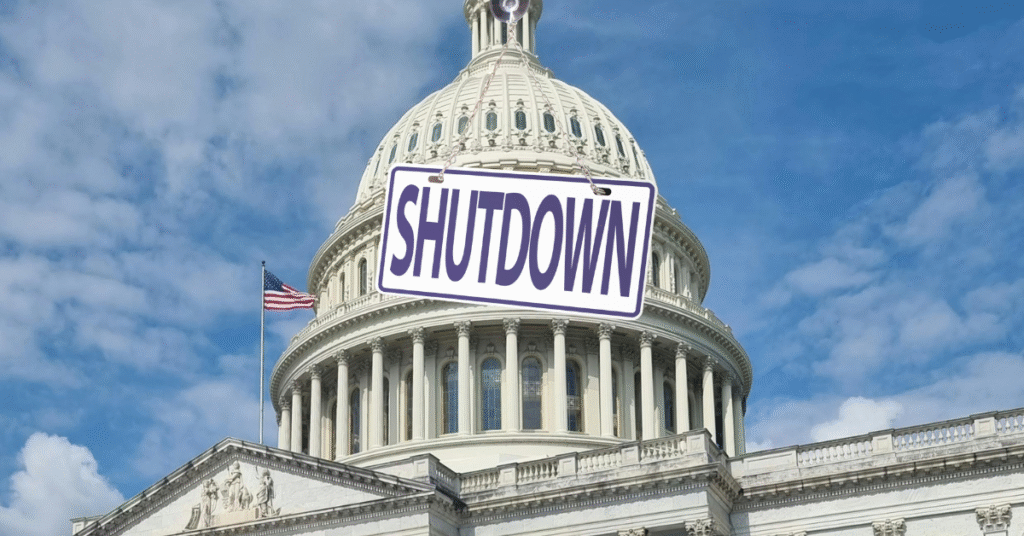Introduction to Shutdown 2025
As Shutdown 2025 enters its fifth day, Washington, D.C. stands still. Federal offices are closed, national museums are shuttered, and hundreds of thousands of workers wait for paychecks that may never come. What began as a funding disagreement has grown into a nationwide crisis — highlighting how political battles can hurt ordinary Americans.
What Is Shutdown 2025?
Shutdown 2025 began on October 1, 2025, when Congress failed to approve a budget for fiscal year 2026. This marks the 11th government shutdown in modern U.S. history. The standoff has left nearly a million federal employees furloughed and hundreds of thousands of “essential” workers continuing without pay.

The Political Spark Behind the Crisis
At the center of the shutdown lies a fierce budget dispute between Republicans and Democrats. President Donald Trump and House Speaker Mike Johnson demanded a short-term spending bill with no “Democrat add-ons,” while Chuck Schumer and Senate Democrats insisted on protecting healthcare funding and extending Affordable Care Act tax credits.
Neither side blinked — and Shutdown 2025 began.
How Project 2025 Fueled the Standoff
The conservative policy blueprint known as Project 2025 intensified the divide. It aims to downsize federal agencies and increase presidential control. Trump has openly embraced it, targeting what he calls “bloated Democrat bureaucracies.” Democrats view it as an attack on social programs, making compromise even harder.
Read more: Understanding Project 2025 and Its Impact on U.S. Policy

Congress Deadlocked Over Budget Talks
Multiple Senate votes have failed to end the standoff. The House remains adjourned until further notice. The longer this impasse lasts, the deeper the pain for federal workers, businesses, and families who depend on government services.
External Source: AP News – Government Shutdown Updates

The Human Cost of the Shutdown
For millions of Americans, this shutdown is a financial emergency. Roughly 900,000 workers are furloughed, while 700,000 essential employees — including air traffic controllers, TSA officers, and Border Patrol agents — are still reporting for duty without pay.
Families are relying on food banks, credit cards, and emergency savings just to survive.
Air Travel and Transportation Disruptions
The shutdown is disrupting daily life. TSA lines are longer, FAA inspections are delayed, and airline maintenance is behind schedule. Travelers face increasing delays and cancellations — a direct consequence of staff shortages and overworked, unpaid employees.

Military Families Feeling the Impact
Active-duty troops continue to serve, but military families are struggling to pay rent and buy groceries. Local food pantries near military bases report record demand as the shutdown stretches on.
Economic Fallout of the Shutdown
Economists estimate that the U.S. economy loses $400 million every day the government remains closed. If Shutdown 2025 lasts several weeks, GDP could fall by 0.2%, while small businesses dependent on federal contracts face layoffs and closures.
External Source: BBC – Economic Impact of Shutdown 2025
Global Consequences
The world is watching. International markets are reacting to U.S. instability, oil permits are stalled, and cryptocurrency regulation has paused. Shutdown 2025 has become more than a domestic issue — it’s a global warning about political dysfunction in America.

Voices from the Shutdown
Social media tells the human story behind the numbers.
“We’re working for free while politicians argue,” says a TSA agent in Chicago.
“My husband’s serving in the Coast Guard, but our rent is due,” writes a mother in Virginia.
These voices capture the real cost of Shutdown 2025 beyond politics and policy.
Media and Public Reaction
From PBS to CNN, analysts have called the shutdown “a political hostage situation.” Some conservatives praise Trump’s stand against “overspending,” while others criticize the chaos it’s creating. The public remains divided — and weary.
Possible Paths to Ending the Shutdown
History shows that government shutdowns often end in exhaustion, not agreement. Analysts suggest the White House might back a short-term funding bill to ease public anger. Others believe Democrats will hold firm until healthcare protections are secured.
Conclusion: The Legacy of Shutdown 2025
Shutdown 2025 has exposed a deeper weakness in America’s political system — a lack of collaboration and compassion. While leaders argue over budgets, ordinary Americans carry the burden. It’s time to restore governance, responsibility, and faith in public service.


